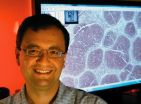(Press-News.org) Researchers have found that a novel form of personalized therapy that genetically engineers a patient's own anti-tumor immune cells to fight tumors could treat metastatic melanoma and metastatic synovial cell sarcoma, representing a potentially new therapeutic approach against these and other cancers.
The technique, called adoptive immunotherapy, works with the body's immune system to fight cancer. Immune cells, called T lymphocytes, are removed, modified, expanded in large numbers, and given back to the patient. In this case, the process entailed genetically engineering T cell lymphocytes to express receptors directed against a specific antigen on the cancer cell.
"We believe that this approach of adoptive immunotherapy is the most effective means for using the body's immune system to combat cancer," said senior study author Steven A. Rosenberg, MD, PhD, chief of the surgery branch at the National Cancer Institute. "This paper represents the first time that adoptive immunotherapy using genetically modified cells has been successfully used to treat a solid cancer other than melanoma because we are targeting an antigen present on many types of cancer."
The treatment resulted in response rates of 45 percent and 67 percent in malignant melanoma and synovial cell sarcoma patients, respectively.
In earlier trials, Rosenberg and colleagues used adoptive immunotherapy on treatment-resistant patients with metastatic melanoma who had extensive prior therapy. Of 93 patients studied, they found that more than half had measurable responses, including 20 with complete disappearance of all melanoma metastases.
In the current study, 17 patients with treatment-resistant metastatic melanoma or metastatic synovial cell sarcoma received therapy with their own immune T cells. The cells were genetically engineered to express a T cell receptor that recognized the NY-ESO-1 cancer-testes antigen on cancer cells. NY-ESO-1 is expressed in one quarter to one third of common epithelial cancers such as those of the breast, kidney, esophagus and other cancer types, and in about 80 percent of synovial cell sarcoma.
Four of six patients (67 percent) with synovial cell sarcoma and five of 11 (45 percent) melanoma patients had measurable tumor regression. Two of the 11 melanoma patients had complete regression lasting for more than one year. The treatments had minimal toxicity.
"The effectiveness of this treatment in patients with synovial cell sarcoma may mean that this new approach can be used for patients with other cancers as well," Rosenberg said, "And potentially lead to new types of immunotherapy. "
Rosenberg's group recently reported the first example of using adoptive immunotherapy to treat a patient with non-Hodgkin's lymphoma, and continues to explore different ways to genetically modify a patient's immune system to treat cancer. They have also recently published results showing that immune cells could be genetically modified to target and destroy the blood vessels supplying nutrients to tumors in experimental models.
###
ASCO Perspective:
Sylvia Adams, MD, Member of ASCO's Cancer Communications Committee
"Several studies have suggested that transfusing immune system T cells can induce cancer regression in melanoma patients. Unlike prior studies, this study used engineered T cells specific for a tumor antigen that is carried by a variety of tumors, including sarcomas, lung cancer, ovarian cancer, malignant melanoma, and breast cancer. This approach broadens the applicability of the technique to several cancers and minimizes toxicity. The observed tumor shrinkage in patients with metastatic sarcoma and melanoma is promising, and if confirmed in additional clinical trials, this immunotherapy may become a new treatment option."
Helpful Links from Cancer.Net:
Understanding Immunotherapy
http://www.cancer.net/patient/All+About+Cancer/Cancer.Net+Feature+Articles/Treatments%2C+Tests%2C+and+Procedures/Understanding+Immunotherapy
Cancer.Net Guide to Melanoma
http://www.cancer.net/melanoma
Cancer.Net Guide to Sarcoma
http://www.cancer.net/sarcoma
The Journal of Clinical Oncology is the tri-monthly peer-reviewed journal of the American Society of Clinical Oncology (ASCO), the world's leading professional society representing physicians who treat people with cancer.
ATTRIBUTION TO THE JOURNAL OF CLINICAL ONCOLOGY IS REQUESTED IN ALL NEWS COVERAGE.
Novel immune system-based gene therapy induces strong responses in metastatic melanoma, sarcoma
2011-02-01
ELSE PRESS RELEASES FROM THIS DATE:
Computer-assisted diagnosis tools to aid pathologists
2011-02-01
Researchers are leveraging Ohio Supercomputer Center resources to develop computer-assisted diagnosis tools that will provide pathologists grading Follicular Lymphoma samples with quicker, more consistently accurate diagnoses.
"The advent of digital whole-slide scanners in recent years has spurred a revolution in imaging technology for histopathology," according to Metin N. Gurcan, Ph.D., an associate professor of Biomedical Informatics at The Ohio State University Medical Center. "The large multi-gigapixel images produced by these scanners contain a wealth of information ...
Explosive- and drug-sniffing dog performance is affected by their handlers' beliefs
2011-02-01
Drug- and explosives-sniffing dog/handler teams' performance is affected by human handlers' beliefs, possibly in response to subtle, unintentional handler cues, a study by researchers at UC Davis has found.
The study, published in the January issue of the journal Animal Cognition, found that detection-dog/handler teams erroneously "alerted," or identified a scent, when there was no scent present more than 200 times — particularly when the handler believed that there was scent present.
"It isn't just about how sensitive a dog's nose is or how well-trained a dog is. There ...
NASA sees large Tropical Cyclone Yasi headed toward Queensland, Australia
2011-02-01
Tropical Storm Anthony made landfall in Queensland, Australia this past weekend, and now the residents are watching a larger, more powerful cyclone headed their way. NASA's Terra satellite captured a visible image of the large Tropical Cyclone Yasi late yesterday as it makes its way west through the Coral Sea toward Queensland.
The Moderate Resolution Imaging Spectroradiometer (MODIS) instrument that flies aboard NASA's Terra satellite captured an image of Cyclone Yasi on Jan. 30 at 23:20 UTC (6:20 p.m. EST/09:20 a.m., Monday, January 31 in Australia/Brisbane local time). ...
Tracking the origins of speedy space particles
2011-02-01
NASA's Time History of Events and Macroscale Interaction during Substorms (THEMIS) spacecraft combined with computer models have helped track the origin of the energetic particles in Earth's magnetic atmosphere that appear during a kind of space weather called a substorm. Understanding the source of such particles and how they are shuttled through Earth's atmosphere is crucial to better understanding the Sun's complex space weather system and thus protect satellites or even humans in space.
The results show that these speedy electrons gain extra energy from changing magnetic ...
UCSB physicists challenge classical world with quantum-mechanical implementation of 'shell game'
2011-02-01
(Santa Barbara, Calif.) –– Inspired by the popular confidence trick known as "shell game," researchers at UC Santa Barbara have demonstrated the ability to hide and shuffle "quantum-mechanical peas" –– microwave single photons –– under and between three microwave resonators, or "quantized shells."
In a paper published in the Jan. 30 issue of the journal Nature Physics, UCSB researchers show the first demonstration of the coherent control of a multi-resonator architecture. This topic has been a holy grail among physicists studying photons at the quantum-mechanical level ...
Children's genetic potentials are subdued by poverty
2011-02-01
Children from poorer families do worse in school, are less likely to graduate from high school, and are less likely to go to college. A new study published in Psychological Science, a journal of the Association for Psychological Science, finds that these differences appear surprisingly early: by the age of 2. It's not a genetic difference. Instead, something about the poorer children's environment is keeping them from realizing their genetic potentials.
Past research has found that a gap between poor children and children from wealthier families opens up early in life, ...
Resolved to quit smoking?
2011-02-01
ANN ARBOR, Mich.--Brain scans showing neural reactions to pro-health messages can predict if you'll keep that resolution to quit smoking more accurately than you yourself can. That's according to a new study forthcoming in Health Psychology, a peer-reviewed journal.
"We targeted smokers who were already taking action to quit," says Emily Falk, the lead author of the study and director of the Communication Neuroscience Laboratory at the U-M Institute for Social Research (ISR) and Department of Communication Studies. "And we found that neural activity can predict behavior ...
Smart lasers could make cancer biopsies painless, help speed new drugs to market
2011-02-01
EAST LANSING, Mich. — Biopsies in the future may be painless and noninvasive, thanks to smart laser technology being developed at Michigan State University.
To test for skin cancer, patients today must endure doctors cutting away a sliver of skin, sending the biopsy to a lab and anxiously awaiting the results. Using laser microscopes that deploy rapid, ultra-short pulses to identify molecules, doctors may soon have the tools to painlessly scan a patient's troublesome mole and review the results on the spot, said Marcos Dantus.
The results touting this new molecule-selective ...
Pakistan floods last summer could have been predicted
2011-02-01
WASHINGTON — Five days before intense monsoonal deluges unleashed vast floods across Pakistan last July, computer models at a European weather-forecasting center were giving clear indications that the downpours were imminent. Now, a new scientific study that retrospectively examines the raw data from these computer models, has confirmed that, if the information had been processed, forecasters could have predicted extremely accurate rainfall totals 8-10 days beforehand.
The study also finds that the floods themselves could have been predicted if this data, which originated ...
Pitt team grows arteries with most elastic protein reported, big step for living vascular grafts
2011-02-01
PITTSBURGH—University of Pittsburgh researchers have grown arteries that exhibit the elasticity of natural blood vessels at the highest levels reported, a development that could overcome a major barrier to creating living-tissue replacements for damaged arteries, the team reports in the Proceedings of the National Academy of Sciences.
The team used smooth muscle cells from adult baboons to produce the first arteries grown outside the body that contain a substantial amount of the pliant protein elastin, which allows vessels to expand and retract in response to blood flow. ...



